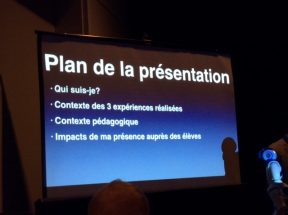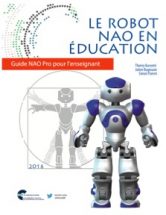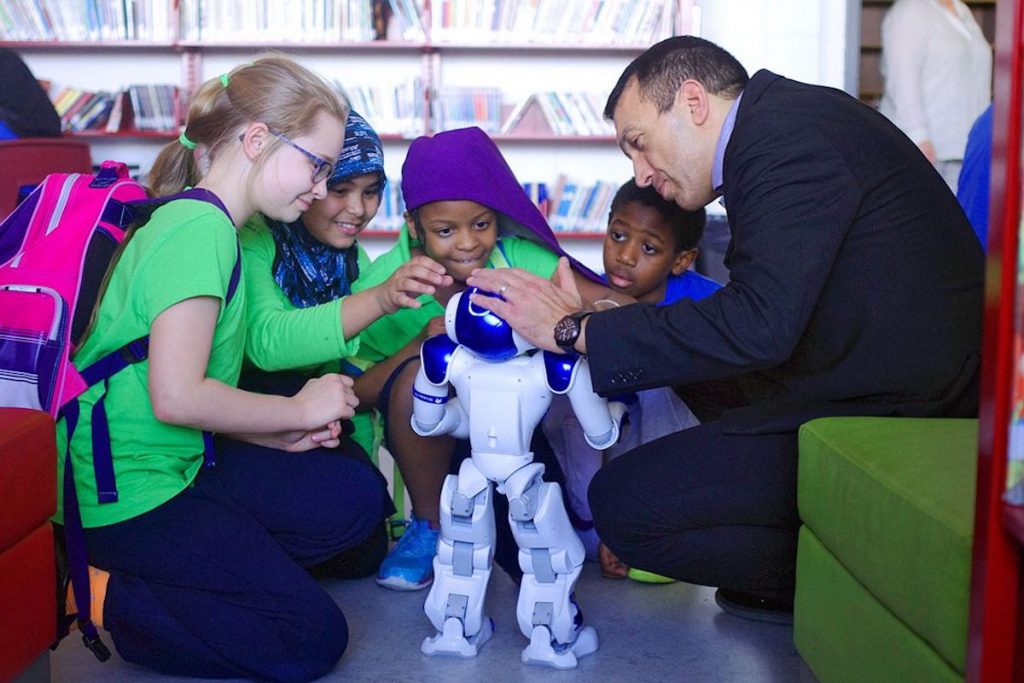En première mondiale au 5e Sommet de l’iPad et du numérique en éducation, qui s’est tenu les 18 et 19 mai 2017 à Montréal, une conférence scientifique a été prononcée par un robot humanoïde, NAO.
 La conférence de NAO était accompagnée de diapositives qu’il semblait faire défiler lui-même en complément de son propos. Il répondait même avec un semblant d’intelligence et d’humour aux questions. Un agréable spectacle pour présenter les travaux de l’équipe de la Chaire de recherche du Canada sur les technologies en éducation sur l’usage de ce robot humanoïde en éducation.
La conférence de NAO était accompagnée de diapositives qu’il semblait faire défiler lui-même en complément de son propos. Il répondait même avec un semblant d’intelligence et d’humour aux questions. Un agréable spectacle pour présenter les travaux de l’équipe de la Chaire de recherche du Canada sur les technologies en éducation sur l’usage de ce robot humanoïde en éducation.
NAO, robot humanoïde programmable, est développé par la société SoftBank Robotics (anciennement Aldebaran Robotics), une start-up française de Paris. La Chaire de recherche du Canada sur les technologies de l’information et de la communication en éducation s’est procuré trois de ces robots, car un seul ne suffit pas pour une classe d’une vingtaine d’élèves.
NAO et les élèves atteints du spectre de l’autisme
Les élèves de Marie-Christine Audet, enseignante à l’école primaire de la Nouvelle-Cadie, à Saint-Gervais dans la région de Bellechasse, ont reçu deux fois la visite de NAO après que ce dernier ait entretenu une correspondance personnalisée avec eux. En conclusion de cette première activité exploratoire, le postdoctorant Julien Bugmann et la conseillère pédagogique en adaptation scolaire à la CS de la Côte-du-Sud Emmanuelle Frenette estiment que l’usage d’un robot comme NAO pourrait avoir « une influence sur le développement de compétences cognitives, conceptuelles, linguistiques et sociales » chez les enfants autistes.
Des élèves programment NAO

À l’école primaire Paul-Jarry, à Lachine, la plus défavorisée de la Commission scolaire Marguerite-Bourgeoys, les élèves ont appris pas à pas à programmer NAO. Par leur intervention, ce dernier a appris, entre autres, à botter un ballon. Il s’agit d’une première mondiale qui a permis de démontrer ses effets bénéfiques en classe. Auparavant, seuls des ingénieurs en informatique programmaient ce robot.
Pour motiver les élèves, les chercheurs ont développé 35 niveaux de programmation. Les recherches passées ont permis d’observer l’attrait auprès des élèves du passage d’un niveau d’expertise à un autre dans les jeux vidéo. Il a commandé à des fournisseurs chinois des ensembles de bracelets colorés correspondants aux divers niveaux à atteindre. Les élèves enfilent ces bracelets lorsqu’ils ont complété les exigences d’un niveau de programmation.
* * *
En résumé, particulièrement grâce à son côté social, NAO est avantageusement utilisé auprès d’élèves ayant un trouble du spectre de l’autisme et en adaptation scolaire, ainsi que pour l’apprentissage de la programmation par tous les élèves du primaire et du secondaire.
Lors du 5e Sommet de l’iPad et du numérique en éducation, NAO avait aussi son propre espace au salon des exposants!
La Chaire de recherche du Canada sur les technologies de l’information et de la communication en éducation a fait une demande de subvention pour acquérir plus d’exemplaires de NAO, qui coutent 6000 $ chacun. Le but est de développer l’autonomie des écoles afin qu’elles puissent utiliser NAO pour apprendre la programmation à leurs élèves sans l’intervention de la Chaire, qui est présentement le moteur des applications pédagogiques de ce nouvel outil.
Voyez NAO en action au CFER de Bellechasse :
https://www.youtube.com/watch?v=duh5ISpLH1g
Pour en savoir plus sur l’usage pédagogique de NAO
 Karsenti, T., Bugmann, J. et Parent, S. (2017). Le robot NAO en éducation. Guide de l’élève pour le niveau NAO PRO. Montréal : offert en téléchargement.
Karsenti, T., Bugmann, J. et Parent, S. (2017). Le robot NAO en éducation. Guide de l’élève pour le niveau NAO PRO. Montréal : offert en téléchargement.
Des robots font l’école aux élèves en difficulté : http://nouvelles.umontreal.ca/article/2017/05/19/des-robots-font-l-ecole-aux-eleves-en-difficulte/
Le robot NAO : un outil pédagogique innovant : http://journalmetro.com/local/outremont-mont-royal/actualites/1145146/connaissez-vous-nao/
Gravel le matin : https://www.facebook.com/gravelmatin/videos/1901517306728191/
Un robot programmé par des élèves :http://www.journaldequebec.com/2017/05/18/un-robot-programme-par-des-eleves






